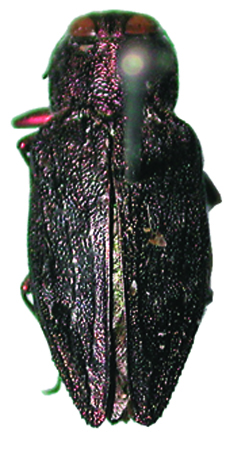Flat-headed apple tree borer
July 30, 2015
 Chrysobothris femorata
Chrysobothris femorata
This is a common pest of newly planted trees and shrubs, including maples, crabapple, hawthorn, linden and oak.
Eggs are laid near bark fissures or wounds and hatch around the time mock-orange blooms. Flat-headed apple tree borer adult (at left) is 7 to 14 mm long with a metallic, dark bronze color.
Management
Avoid leaving tree wrap on for more than a season. Larvae may be found injuring the bark underneath tree wrap that has been left on for extended periods of time. If injury is not extensive, damaged areas of bark can be cut back to healthy tissue and larvae can be removed. Keep newly planted trees and shrubs well-watered and mulched, as stressed plants are more prone to injury by this insect. Adults are stouter than either two-lined chestnut borers or bronze birch borers.

Larvae feed in the cambium and sapwood. Look for darkened patches of bark from oozing sap and fine bits of frass on the trunk.
Print a PDF of this page: Flat-headed apple tree borer.



 Print
Print Email
Email



